Word on the street > That Was the Winter of Our…Great Content; Bringing the Outside World In: Learning From Other Industries
Word on the Street: Issue 190
Weekly real-time market and industry intelligence from Morrissey Goodale firm leaders.

That Was the Winter of Our…Great Content
Spring officially kicked off two weeks ago. And what a winter it left in the rearview mirror of your plug-in hybrid. Not only was it the warmest on record for the contiguous 48 states (I knew I shouldn’t have bought that whole-house generator), but it also saw yet another quarter of record financial performance for our industry.
In the opening monologue of Richard III, “Now is the winter of our discontent, made glorious summer by this sun of York,” the king ponders how his fortunes may soon change for the better. This week, as we head into the season when field operations kick into high gear around the country, industry CEOs (our kings) are no longer just wondering how long the good times will last, but also how their fortunes have changed after a decade-long sea change in industry performance and dynamics.
1. A winter of contentedness: At the end of last month at our 10th annual Southeast M&A and Business Symposium in a sun-drenched Miami, 200-plus industry executives and investors were present when our own Nick Belitz and Deltek’s Megan Miller shared the current State of the Industry—a compendium of real-time industry performance indicators sourced from the most recent Deltek Clarity: Architecture & Engineering Industry Survey and Morrissey Goodale proprietary databases. Nick and Megan presented some jaw-dropping data about the amazing performance of the industry this past winter and its near-term prospects. The headline? Almost every key gauge of industry financial performance hit records in Q4 of 2023—with many of them off-the-charts positive.
2. Pump it up: The industry’s remarkable fourth quarter capped a remarkable 10-year run. It’s like on New Year’s Eve 2013, every industry CEO made a resolution to get their firms into shape. Then they jumped out of their beds the next morning bright and early; laced up their HOKAs; went to the gym on January 1, 2014; and then never missed a daily workout (not even to skip leg day) for the next decade. And over each of those 10 years, the industry continually improved, setting consecutive annual records. How has industry financial performance improved since 2013? Looking at the Deltek data, profits, revenues, utilization, and revenues per employee increased every single year, while overhead dropped annually. What about financial condition? Balance sheets got stronger every 12 months. Even during the pandemic year. More cash, more equity for everybody! Minimum levels of debt and indebtedness.
3. Slow turning: And while the industry has gone from strength to strength over the past 10 years, it has also changed—slowly, but surely. Just think, in 2014 over three-quarters of the ENR Top 100 firms were employee-owned. Today, that’s down to two-thirds. Over the same period, the percentage of ENR Top 100 firms that have majority- or minority-private equity positions has increased from less than 4% to 21%. Over 3,300 design and environmental firms have been sold (or in business-speak “consolidated”) over those same 10 years, creating thousands of overnight millionaires and multi-millionaires. A massive and transformational wave of consolidation—that continues to have legs. Cyberattacks. Digital twinning. Artificial Intelligence. Hybrid work. All unheard of a decade ago. Every single one omnipresent today.
4. From commodity to conqueror: A decade ago it was not uncommon for CEOs to express worry about the rapid commoditization of their firm’s services and concern about the fate of the industry. Today, there is little talk of commoditization, and instead of concern there is confidence. Board discussions are around investments—in expansion, diversification, new technologies, and new ways of working. These strategic conversations are infused with a sense of optimism about the short-term prospects for the industry—buoyed by anticipated public-sector infrastructure investments and the need for more housing everywhere. The beautiful asymmetry between demand and supply is here for years to come. And in terms of the longer-term outlook? The strategic conversations we are facilitating involve either serving up or preparing for the technological disruptions. With a collective sense of curiosity and ambition, leadership teams are pushing boundaries and breaking long-standing traditions to drive financial performance that was unimaginable 10 years ago. The big challenges that have not changed, but have only gotten worse over the past decade? Leadership and ownership transition for employee-owned firms.
“And all the clouds that lour’d upon our house, In the deep bosom of the ocean buried.” At the start of 2013, our industry was still very much tied to what it had experienced in the Great Recession. That slow, slow recovery after 2008 left its mark on both its financial condition and on the mindset of its leaders. But now, it’s a different game. Those days are long, long gone. A remarkable change has taken hold over this past decade. And another bright decade lies ahead.
To connect with Mick Morrissey, email him at [email protected] or text him at 508.380.1868.
Bringing the Outside World In: Learning From Other Industries
Installment #2: HUMAN RESOURCES
Whether it’s maintaining a healthy company culture, sustaining productivity, or advancing the training and development of employees, work dynamics remain a significant challenge in the wake of the pandemic. However, amidst the turmoil, several industries have pioneered innovative HR strategies tailored to the transformed business landscape. This week, we return to our best practices series to draw inspiration from these developing innovations and give thought to how AE firms can reimagine their own HR approaches to the many challenges that lie ahead—and the ones that are already here.
Here are four HR strategies developed and implemented by businesses in other industries since 2020, followed by how AE firms can adapt them for their own use.
Skills Development Initiatives
Looking outside: LinkedIn launched its skills development initiatives in March 2020, offering employees access to online learning resources and training programs. Through the LinkedIn Learning platform, employees can explore a vast library of courses covering diverse topics ranging from technical skills such as data analysis and software development to soft skills like leadership and communication. The program allows employees to customize their learning paths based on their interests, career goals, and job requirements. Additionally, employees have the flexibility to learn at their own pace, accessing courses anytime, anywhere, through web browsers or mobile devices. LinkedIn Learning also offers interactive features such as quizzes, exercises, and project-based learning experiences to enhance engagement and retention of knowledge. Furthermore, employees can track their progress, earn certifications upon completion of courses, and showcase their newly acquired skills on their LinkedIn profiles, facilitating professional growth and career advancement opportunities. Employees who participated in LinkedIn’s skills development programs reported a 30% increase in job satisfaction and a 25% improvement in performance metrics. Additionally, the organization observed a 20% decrease in turnover rates among employees who actively engaged in skill-building activities.
Bringing it inside: AE firms can provide employees with access to online training courses and certifications in emerging technologies. For example, offering courses in sustainable design practices or advanced modeling software can enhance skill sets and job satisfaction.
Remote Onboarding Experience
Looking outside: Shopify redesigned its onboarding process for remote hires in April 2020 by leveraging virtual orientations and digital resources to provide new employees with a seamless and immersive experience. The program typically begins with a personalized welcome package delivered to the new hire’s doorstep, containing essential onboarding materials, company swag, and instructions for accessing digital resources. Virtual orientation sessions are conducted via video conferencing platforms, where new hires are introduced to key company stakeholders; learn about the organization’s culture, values, mission, and vision; and receive an overview of their roles and responsibilities. Digital resources—such as online training modules, interactive onboarding portals, and virtual tours of company facilities—supplement the orientation sessions, providing new hires with comprehensive insights into the company’s operations, processes, and tools. Additionally, assigned mentors or buddy systems offer ongoing support and guidance to help new hires acclimate to their roles and integrate into the company culture successfully. Remote hires who experienced Shopify’s revamped onboarding process reported feeling more connected to the organization, with a 40% increase in engagement levels compared to traditional onboarding methods. Additionally, the “time-to-productivity” for remote hires decreased by 15% following the implementation of the new process.
Bringing it inside: Consulting engineering firms can revamp their onboarding process to accommodate remote hires, providing them with virtual orientation sessions and access to digital resources. For example, creating interactive onboarding modules that introduce new hires to the firm’s culture and project methodologies can facilitate a smooth transition into the organization.
Well-Being Workshops and Resources
Looking outside: Google began offering well-being workshops and resources in June 2020 to support employees’ physical and mental health. These initiatives, still in use today, typically encompass a variety of formats, including virtual workshops, webinars, and interactive sessions led by certified professionals and internal experts. Topics covered range from stress management and mindfulness techniques to nutrition, fitness, and work-life balance strategies. Additionally, Google provides access to digital resources such as wellness apps, online courses, and self-help tools to empower employees to take proactive steps towards improving their well-being. Furthermore, the company encourages employees to seek help when needed and provides access to confidential counseling services and mental health resources. Google observed a 25% reduction in stress-related absenteeism among employees who participated in well-being workshops. Additionally, employee satisfaction scores increased by 15% following the introduction of mental health resources and support programs.
Bringing it inside: AE firms can prioritize employee well-being by offering virtual wellness workshops and access to mental health resources. For example, providing employees with access to counseling services and wellness seminars can help mitigate stress and improve overall employee satisfaction.
Asynchronous Communication Practices
Looking outside: Slack began promoting asynchronous communication practices in January 2021 to facilitate collaboration across different time zones and work schedules. The program involves leveraging Slack’s platform features to enable communication and information exchange that are not dependent on real-time interaction. Specific aspects of the program include encouraging the use of channels and threads to organize discussions and share updates, which allows team members to contribute and catch up on conversations at their convenience. Slack’s integration with project management tools and file-sharing platforms enables teams to collaborate on tasks and projects asynchronously, with notifications and updates being delivered in a non-disruptive manner. The company observed a 25% reduction in communication-related bottlenecks and delays following the adoption of asynchronous communication practices and received feedback from employees that work-life balance improved 20%.
Bringing it inside: AE firms can embrace asynchronous communication tools and practices to facilitate efficient collaboration among distributed teams. For example, leveraging collaborative platforms and shared documents can minimize communication delays and enhance productivity in remote work environments.
Our “Bringing the Outside World In” series continues in two weeks with an installment on project management strategies. In the meantime, for help developing innovative human resources strategies for your firm, call Mark Goodale at 508.254.3914 or email [email protected].
Market Snapshot: An Update on Architecture Demand
For the past seven months, the demand for architecture services has been below the AIA’s Architecture Billings Index mark of 50, which indicates contraction in business activity. However, a 7% month-over-month improvement (the highest since March 2022), an increase in new design contracts, and strong jobs gains in February reflect a potential turn towards stronger business conditions within the architecture industry.
- Firms specializing in the institutional sector have experienced the best business environment and highest growth in billings over the past year, increasing by 8% compared to last February.
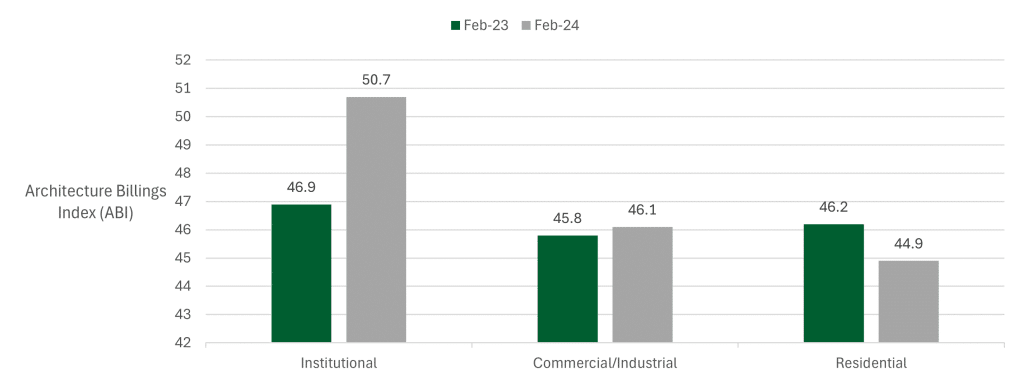
- Since the broader slowdown that started in the second half of 2023, the Midwest region has recovered more quickly than others, returning to positive territory (ABI above 50) in December.
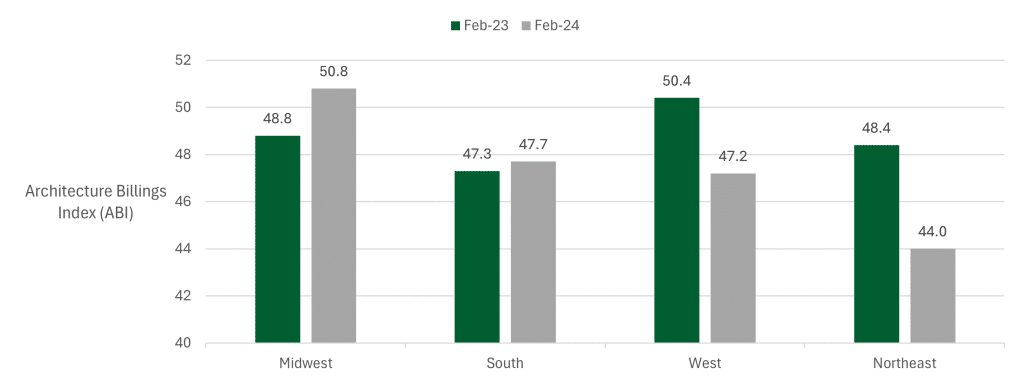
For the latest insights on U.S. regions and AE markets, check out our 2024 AE Market Intelligence Webinar. Click here to access recording and materials.
To learn more about market intelligence data and research services offered by Morrissey Goodale, schedule an intro call with Rafael Barbosa.
Weekly M&A Round Up
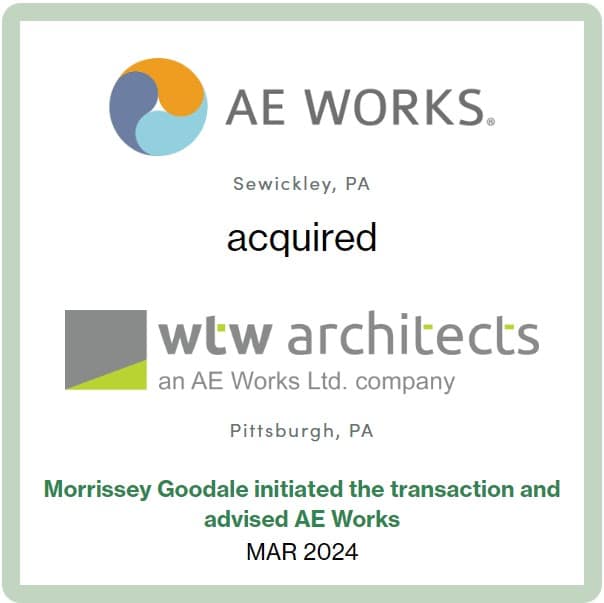
Congratulations to AE Works (Sewickley, PA): In a move that creates one of the largest architectural firms in the region, AE Works acquired WTW Architects (Pittsburgh, PA), a firm with extensive design experience in higher education, commercial, and health care projects. This acquisition is a key part of AE Works’ strategic firm vision to diversify its experience in the region and nationwide. We’re thankful that the AE Works team trusted us to initiate and advise them on this transaction.
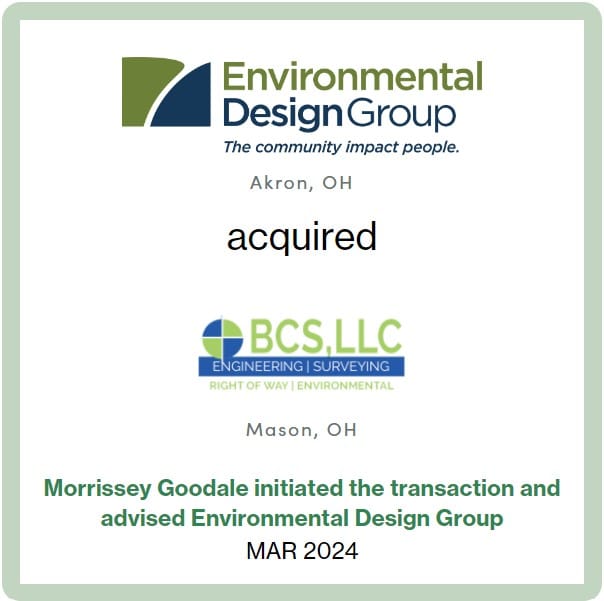
Another congrats to Environmental Design Group (EDG) (Akron, OH): The planning, design, and civil engineering services firm acquired BCS (Mason, OH), an engineering, surveying, right-of-way acquisition, and environmental services firm. This strategic move represents a significant milestone in EDG’s growth and expands the firm’s infrastructure solutions. We feel privileged that the EDG team trusted us to initiate and advise them on this transaction.
Domestic deal activity down 3%: Last week we reported five additional domestic transactions, including deals by three ENR Top 500 firms—one in Arkansas and two in New Jersey. You can check all the week’s M&A news here.
June 12-14, 2024 Las Vegas, NV
Western States M&A and Business Symposium
Join us for the 10th annual Western States Symposium, bringing together over 200 AE and environmental industry executives and investors in one of the world’s most vibrant and iconic cities.
Learn More
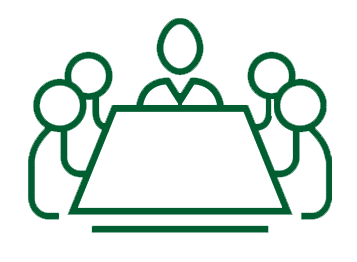
Searching for an external Board member?
Our Board of Directors candidate database has over one hundred current and former CEOs, executives, business strategists, and experts from both inside and outside the AE and Environmental Consulting industry who are interested in serving on Boards. Contact Tim Pettepit via email or call him directly at (617) 982-3829 for pricing and access to the database.
Are you interested in serving on an AE firm Board of Directors?
We have numerous clients that are seeking qualified industry executives to serve on their boards. If you’re interested, please upload your resume here.
Subscribe to our Newsletters
Stay up-to-date in real-time.











